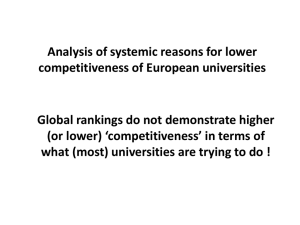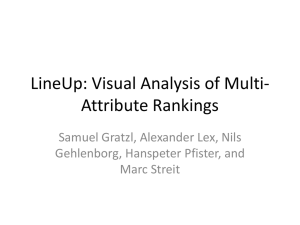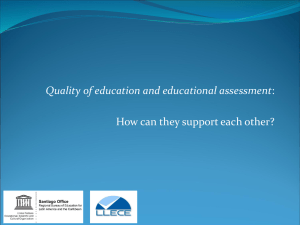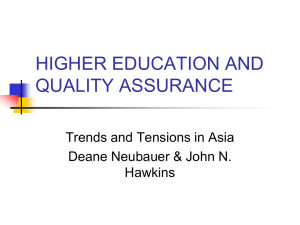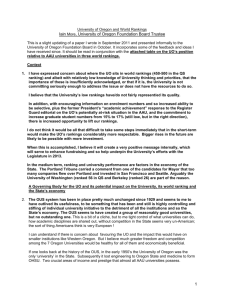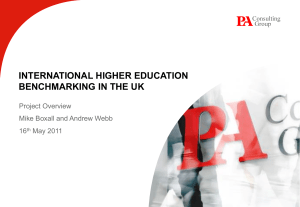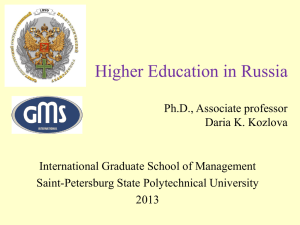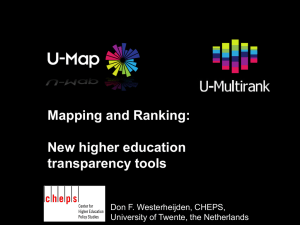Selection of rankings
advertisement
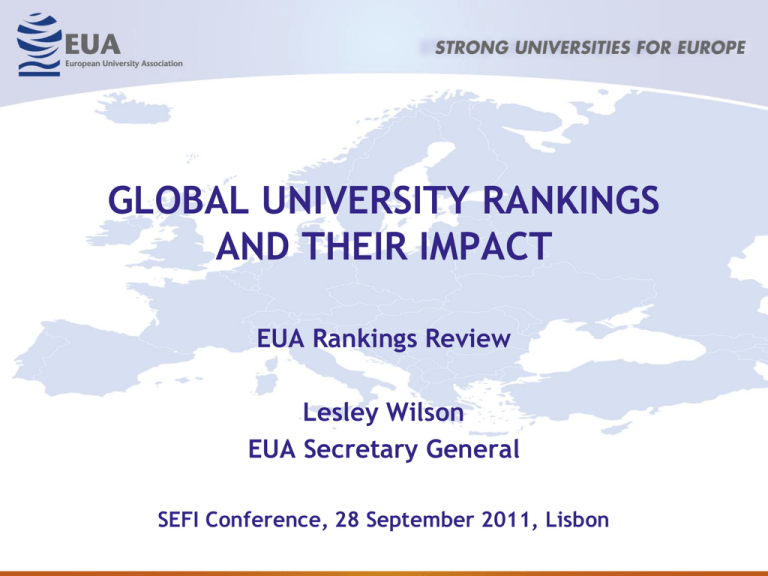
GLOBAL UNIVERSITY RANKINGS AND THEIR IMPACT EUA Rankings Review Lesley Wilson EUA Secretary General SEFI Conference, 28 September 2011, Lisbon I. Purpose and principles of the review Addresses the most popular global university rankings as well as some other international rankings. Provide universities with analysis of the methodologies, not judging or ranking the rankings themselves Use only publicly available and freely accessible information on each ranking, rather than surveys or interviews with the ranking providers Efforts were made to discover what is actually measured, how the scores for indicators are calculated how the final scores are calculated, and what the results actually mean. II. Selection of rankings included in the Review Academic rankings with the main purpose of producing university league tables Academic Ranking of World Universities (Shanghai) Times Higher Education World University Ranking – with Quacquarelli Symonds (until 2009) with Thomson Reuters Best Universities Ranking – US News & World Report with Quacquarelli Symonds Global Universities Ranking – Reitor (Рейтор, Russia) …3… Selection of rankings (contd.) Rankings concentrating on research only Leiden Ranking (Leiden University) Ranking of Research Papers for World Universities – (HEEACT, Taiwan) Assessment of University-Based Research – EU Multirankings – using a number of indicators without the intention of producing league tables CHE/die Zeit University Ranking (CHE, Germany) CHE Excellence Ranking U-Map classification (CHEPS) European Multidimensional University Ranking System (U-Multirank) – EU funded project Selection of rankings (contd.) Web rankings Webometrics Ranking of World Universities (Webometrics, Spain) Benchmarking based on learning outcomes Assessment of Higher Education Learning Outcomes Project (AHELO – OECD) Number of universities III. Characteristics – 1. Global rankings cover not more than 3-5% of world’s universities Other 16,500 universities Next 500 Top500 Top20 Performance …6… 100 80 2. The scores almost disappear at the count of 400 universities What does this means for the scores of the remaining 16’600 universities? 60 TFE-QS THE-TR ARWU 40 HEEACT 20 0 …7… 0 200 400 3. Main Considerations emerging from the analysis The indicators used cover elite universities only Indicator scores are not the indicator values themselves but the results of mathematical operations Composite scores always contain subjective elements (reflecting qualitative choices made by each ranking provider) Choosing between simple counts or calculating relative values is not neutral (size or concentration) …8… 4. Indicators used to define research mission Number of publications: ARWU 2 indicators, total weight 40%: publications in Nature and Science & publications indexed SCI & SSCI HEEACT – 4 indicators overall weight of 50% THE-QS – none, THE-TR 1 indicator weight of 4.5% Number of Citations (or citations/staff) Other research indicators: Research reputations surveys Research income, Intensity of PhD production …9… 5. Rankings & the teaching mission of universities ARWU - Quality of education = alumni that have been awarded a Nobel Prize/ Field medal THE-QS – staff/student ratio, employer survey (answers world wide (3281 in 2009, 2339 in 2008) CHE – a number of indicators based of student opinion + reputation surveys of professors, THE-TR: reputational survey on teaching, student/staff ratio, income per academic, partly, PhDs awarded per academic, PhDs vs. bachelor degrees awarded U-Map and U-multirank – a number of indicators characterizing learning environment rather than its quality …10… IV - Main Biases and Flaws identified 1. Natural sciences and medicine vs. social sciences bias Bibliometric indicators primarily cover journal publications Natural and life scientists primarily publish in journals, Engineering scientists - in conference proceedings, Social scientists and humanists – in books …11… Example:21 broad subject areas defined by ISI 1. Agricultural Sciences 2. Biology & Biochemistry 3. Chemistry 4. Clinical Medicine 5. Computer Science 6. Ecology/Environment 7. Economics & Business 8. Engineering 9. Geosciences 10.Immunology 11.Materials Science 12. Mathematics 13. Microbiology 14. Molecular Biology & Genetics 15. Neuroscience 16. Pharmacology 17. Physics 18. Plant & Animal Science 19. Psychology/Psychiatry 20. Social Sciences, General 21. Space Sciences …12… 2. Different publication and citation cultures in different fields Table from presentation of Cheng at IREG 2010 conference in Berlin …13… 3. Field-normalisation – solutions and issues Field-normalised citations per publication indicator (Leiden ‘Crown indicator’) New attempt (2010) - mean-normalised citation score (MNCS) …14… 4. Impact factor – to be used with care ... especially in social sciences and humanities, expert rankings do not correlate very well with impact factors. (EU WG on assessment of university research, 2010) “the impact factor should not be used without careful attention to the many phenomena that influence citation rates, as for example the average number of references cited in the average article. The impact factor should be used with informed peer review” (Garfield, 1994) “by quantifying research activity and impact solely in terms of peer-publication and citations, rankings narrowly define ‘impact’ as something which occurs only between academic ‘peers’” (Hazelkorn, 2011). …15… 5. ‘Peer review’ biases and flaws Why are reputation surveys called “Peer reviews”? ‘Peers’ are influenced by previous reputation of the institution i.e. a university which ranks highly in one ranking is likely to obtain a high reputation score Limiting the number of universities nominated (THE rankings) makes approach elitist – and probably previous reputation dependent Using pre-selected lists rather than allowing ‘peers’ free choice means that large numbers of institutions are left out Is a 5% response rate a sufficient result? …16… V. – Recent Developments Assessment of university-based research (AUBR): Analysis of research indicators, and their suitability, working out a methodology research assessment. U-Map uses indicators that characterise the focus and intensity of various aspects in HEIs EU-Multirank will be a multidimensional ranking including all aspects of an HEI’s work – education, research, knowledge exchange and regional involvement. No composite score is produced. OECD’s AHELO project is an attempt to compare HEIs internationally on the basis of actual learning outcomes. 3 testing instruments are being developed: for measuring generic skills & for testing disciplinespecific skills, in economics …17… and engineering. VI Consequences - Even keeping current position requires great effort (1) Salmi attributes this phenomenon to the ‘Red Queen effect’ (Salmi, 2010). “In this place it takes all the running you can do, to keep in the same place”, says the Red Queen in Lewis Carroll’s ‘Through the Looking Glass’. The principle was later also articulated in relation to biological systems (Valen, 1973), as for “an evolutionary system, continuing development is needed just in order to maintain its fitness relative to the systems it is co-evolving with” (van Heyligen, 1993). …18… 2. The risks of overemphasising rankings Rankings encourage universities to improve their scores. Universities are strongly tempted to improve performance specifically in areas that are measured in rankings, e.g. research in sciences and medicine. The risks are that universities by concentrating funds and efforts on rankings universities may pay less attention to issues that are not rewarded in ranking scores, e.g. quality of teaching, regional involvement, widening access, lifelong learning, social issues of students and staff etc. …19… 3. Considering how can rankings be improved? There will be no improvement from extending 5 distant proxies to 25 – they will still remain proxies... Improve coverage of teaching – most probably through measuring learning outcomes, Lift biases, eradicate flaws of bibliometric indicators: field, language, regional, but first of all – address nonjournal publications properly! A number of university rankings claim that they help students to make their choices. So change rankings in such a way that they reflect what students need, not what you can measure! Rankings cover only top institutions but impact all universities – can rankings be changed to address a larger number? …20… VII - Main conclusions 1. The arrival on the scene of global rankings has galvanised the world of higher education. Since then universities cannot avoid national and international comparisons, and this has caused changes in the way universities function. 2. De facto, the methodologies of global rankings give stable results for only 700-1000 universities. The majority of universities are left out of the equation – but the result is that all HEIs are judged according to criteria that are appropriate for the top research universities only. 3. Rankings so far cover only some university missions. …21… Main conclusions (contd.) 4. Rankings, it is claimed, make universities more ‘transparent’. However, the methodologies, especially those of the most popular league tables, still lack transparency themselves. 5. The lack of suitable indicators is most apparent when measuring teaching performance. The situation is better when evaluating research. However, even the bibliometric indicators have their biases and flaws. Efforts are made to improve methodologies, usually addressing the calculation method, while the real problem is the use of inadequate proxies, or the omission of part of the information due to methodological constraints …22… Main conclusions (contd.) 6. At present, it would be difficult to argue that the benefits offered by the information that rankings provide, as well as the increased ‘transparency,’ are greater than the negative effects of the so-called ‘unwanted consequences’ of rankings. 7. New attempts as the AUBR EU Research Assessment, U-Map, U-Multirank and AHELO, all aim to improve the situation. These new tools are still at various stages of development or pilot implementation, and all of them still have to overcome difficult issues, particularly problems of data collection and the development of new proxies. 8. Higher education policy decisions should not be based solely on rankings data. …23… Each in his own opinion Exceeding stiff and strong, Though each was partly in the right, And all were in the wrong! by John Godfrey Saxe (1816–1887)

